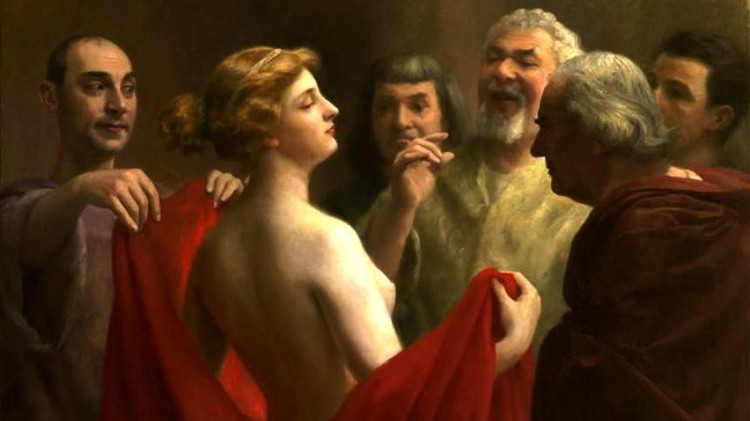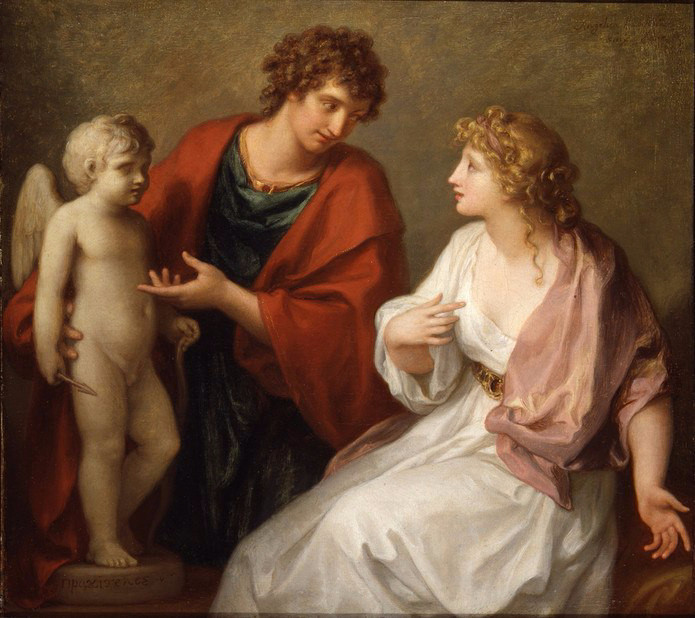The story of the village girl escaping death sentence by ... showing off the chest of Greek mythology
For the ancient Greeks, the human body was the most beautiful creation that gods had bestowed. Nothing is tolerable, simply art.
Each of us has a sense of beauty in different ways. But for the ancient Greeks, the most beautiful, magical creature was the human body.
A lot of ancient Greek artworks, from painting to sculpture, almost everything is shown to expose the natural beauty of people. The human body with them is a pinnacle of beauty, the most precious thing bestowed by gods.
Here is a story that best illustrates the concept of the beauty of the Greeks. The story of Phryne - a famous prostitute of the ancient city of Athens, who passed the death sentence just by . showing off her chest. No one dared to kill her, for destroying a beautiful beauty - it was like a crime against the gods.

"Phryne" by José Frappa (1904).
Phryne - the village girl goes into ancient Greek art
In ancient documents, Phryne was born in Thespian (Boeotia), but spent most of his life in Athens. Although the exact time is unknown, the historians believe that she lived in the period of 371 BC, the time when Thebes defeated Thespiae, pushing the people here to earn their living.
Her real name is Mnesarete , but later people call her Phryne because of her complexion. Phryne means the toad, but contrary to the ugliness in the name, she has a beautiful tilt of water. Therefore, Phryne became the inspiration for many artists and sculptors, including Praxiteles, a famous sculptor in the 4th century BC.

Praxiteles gave the Cupid statue to Phryne - the work of the artist Angelica Kauffman (1794).
Even Praxiteles' Phryne statue was later acquired by the city of Cnidus, thus helping the city pay off its debt because it attracted so many tourists to admire it.
Phryne's beauty also went into poetry, praised by ancient Greek scholars. Athenaeus - a famous scholar in the 3rd century BC once mentioned in an ancient script as follows:
Phryne was a beautiful woman, but extremely discreet, and it made that beauty more mysterious. It's not easy to see her naked: she often wears a cloak that is full of people and never uses a public bath.
Her beauty was used by Apelles to paint the god Aphrodite and the sculptor Praxiteles, with her complete love for her, taking the model she carved into Aphrodite at Cnidus.
Wealth and power
In Athenaeus' document, it is mentioned that, with the beauty and respect of men, Phryne became the wealthiest "self-employed" woman in Athens at the time. She was so rich that she was willing to sponsor the government to rebuild Thebes wall after being destroyed in 336 BC. However, the wall was never built, because the society's point of view was not to accept women's money, especially when the woman was a prostitute.

Phryne charm Xenocrates (1794) by Angelica Kauffman.
Death sentence and beauty continue to go into history
Beauty, money and famous lovers, but what put Phryne's name in history is a breathtaking escape.
In his document, Athenaeus wrote about this conviction. Phryne was brought to court, and the one who pleaded for her was Hypereides - also one of Phryne's lovers. It is unclear why there was this trial, but many historians believe that Phryne was accused of disrespect.
In fact, this story is still very controversial among historians. But according to Athenaeus's record, in order to justify Phryne, Hypereides did an unexpected act: Standing before the trial, he snatched the robe, exposing the chest described as "as beautiful as there is a hand of the god created ".

Phryne in court of Jean-Léon Gérôme (1861).
Hypereides begged for Phryne but was ineffective. Standing in front of the judges, he jerked off her cloak and didn't seem to need to say anything else.
He pleaded for the mercy of the judge before that beauty, threatening them with invisible fears, that it would be a crime to destroy the "nun of the beauty god Aphrodite" .
She was released, and the verdict was written as follows: "No one should provoke any more, and no one has the right to decide on this sentence at the present time."
Phryne stepped out of the court, and her victory became a legacy, an infinite source of inspiration for the art world. These include the French artist Jean-Léon Gérôme (1861), or José Frappa (1904), the sculptor Alexandre Falguière (1948).
In addition, it became a symbol of freedom for many scholars, although many of us must agree that Phryne's actions in the past did not conform to moral standards at the present time. at.
- The strange disappearance of the Kingdom of Minos
- 10 mystical monsters
- Interesting truth about Zeus in Greek mythology
- Unearthed 1,600-year-old Roman mosaic paintings
- The 'one-eyed giant' - the mythical figure turned out to be real
- The mural paints Apollo 2,000 years old
- Enjoy the pure Milky Way season
- Lamia: Women love is forgotten in Greek mythology
- Detecting the ghost of
- The unique villages in the world
- Legend of the three-headed dog monster guarding the gates of hell
- Why is liver cancer today no longer a death sentence?
 'Fine laughs' - Scary and painful torture in ancient times
'Fine laughs' - Scary and painful torture in ancient times The sequence of numbers 142857 of the Egyptian pyramids is known as the strangest number in the world - Why?
The sequence of numbers 142857 of the Egyptian pyramids is known as the strangest number in the world - Why? History of the iron
History of the iron What is alum?
What is alum?